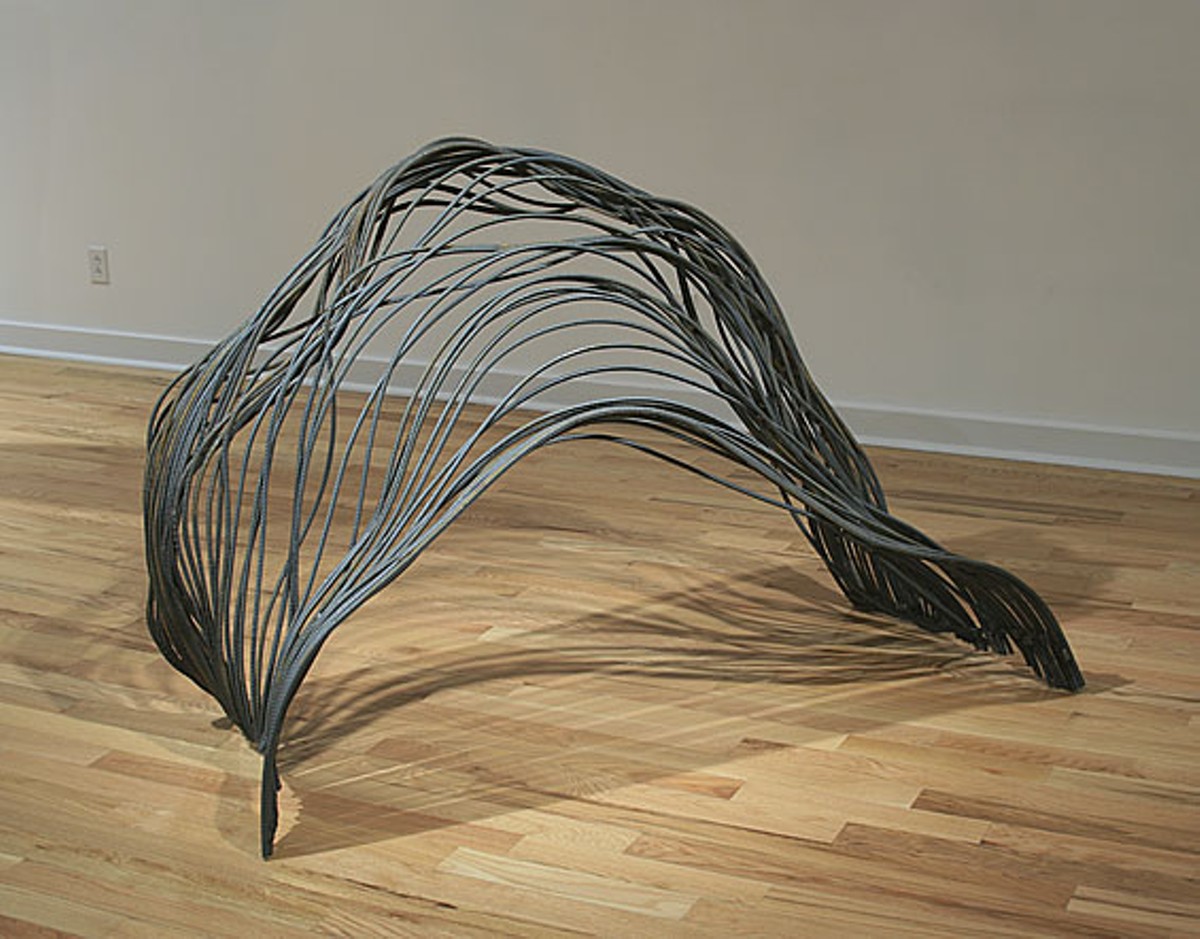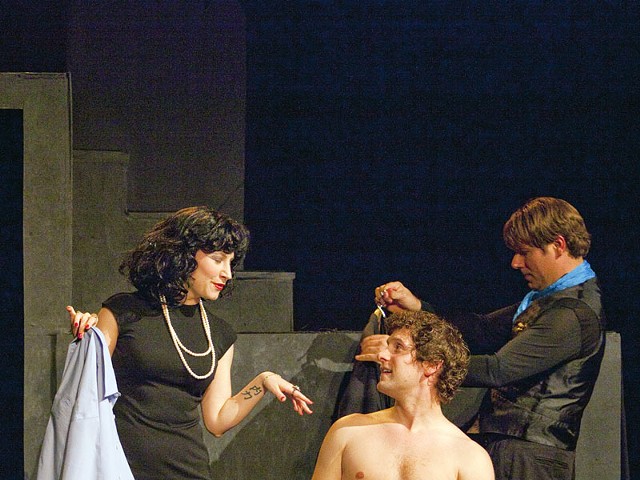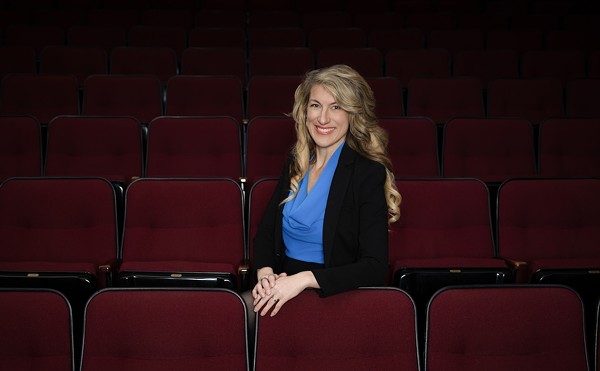Newly Reviewed
Infrastructure Reversing the everyday use of rebar, local sculptor Arny Nadler exposes the ribbed steel to exploit its formal potential. Strands of the metal are joined side by side and shaped into undulating, wave-like forms, producing work that is at once delicate, porous and weightily proletarian. Accompanying the Rebar Studies are upright, totemic sculptures made of concrete, beneath the surface of which rebar writhes and occasionally protrudes with stitch-like ridges. These works appear like cloaked figures, the surface texture of the concrete revealing all the imprints of plastic coverings and other molding devices, producing the vague appearance of wrinkled and lacerated skin. While these roughly elegant works proclaim a determined formalist agenda, they — like Nadler's other evocative sculpture series, Beacons — suggest strong narrative associations, from the bound body and oceanic waves to the decline of industry and disappearance of cottage-craft expertise. Through January 8, 2011, at Good Citizen Gallery, 2247 Gravois Avenue; 314-348-4587 or www.goodcitizenstl.com. Hours: noon-5 p.m. Fri.-Sat. and by appointment.
Pae White: Dying Oak In this cosmos-like trip through the inner strata of an 800-year-old oak tree, Los Angeles-based Pae White creates a digital approximation of her dangling, delicately handmade mobiles and tapestries. White's work, which has previously focused on the details of traditional craft and the minutiae of nature, here takes on the medium of video with the same obsessive, patient eye. Each pixel in this animation appears, like White's mobiles, to dangle from invisible strands; the viewer is drawn in and through the impossible space of the tree's interior as though it were simultaneously solid and penetrable. Striking a mesmerizing balance between the urge to deeply and pragmatically study a subject and simply absorb the intangible qualities of its aesthetic presence, Dying Oak draws something tactile out of the virtual ether. Also showing — Portraits of Depression-era America This collection of photographs, predominantly drawn from Farm Security Administration commissions, is a frank testament to the art of directness, in which candid documents convey formalist sophistication and profound humanism — and exemplify one of the finest uses of federal funding. Through January 9 (Depression) and January 16 (Oak), 2011, at the Saint Louis Art Museum, 1 Fine Arts Drive (in Forest Park); 314-721-0072 or www.slam.org. Hours: 10 a.m.-5 p.m. Tue.-Sun. (10 a.m.-9 p.m. Fri.).
Ongoing
Ab/Fig Curated by erstwhile Chicago gallerist Wendy Cooper, this group show focuses on work that deliberately straddles abstraction and figuration. With its signature blurring of an otherwise straightforward female nude, a piece by Gerhart Richter feels like the point of origin for this approach. A cursory glance at a print by Ellen Gallagher appears to explore geometric abstraction, while close inspection reveals a pale overall patterning of full, line-drawn lips, her definitive and racially charged motif. Three water colors by painter Barnaby Furnas feature figures shattered by war wounds or excess smoking; the vamping blonde in Girlfriend 1 and Girlfriend 2 has her vanity dismantled by her bad habit, while the stoic soldier in Bits and Pieces is shattered into blood-colored shards. A series of oil paintings by Katherine Bradford depicts swimmers in various states of wavering submergence, their bobbing heads barely discernible beneath thick passes of paint. Whether this show is yet another response to Clement Greenberg's now half-century-old dictates about the supremacy of abstraction (as the title's play on Ab/Ex suggests), it seems certainly to attest to the argument's persistence. Figuration is alive and well, and apparently living in blithe harmony with its non-objective antagonists, producing a new brand of perfectly acceptable if not altogether traditional contemporary art. Through January 15, 2011, at William Shearburn Gallery, 4735 McPherson Avenue; 314-367-8020 or www.shearburngallery.com. Hours: 10 a.m.-5 p.m. Tue.-Sat.
Ahmet Ogut: Underestimated Zones Amsterdam-based Turkish artist Ahmet Ogut stages a number of interventions that blend political activism with Buster Keaton-esque slapstick, highlighting the too-fine distinction between absurdity and moral efficacy. In one series of photographs, the artist has hung a sign, guerrilla-style, in undisclosed but distinctly urban St. Louis locations. The sign reads: "Under 23 Hour Surveillance," the Orwellian aura of ubiquitous intrusion undermined by the potential for a random hour of unsupervised chaos. Elsewhere a dual slide projection transforms two unsuspecting commuter cars into a taxi and a police vehicle, via awkward paper appliqués the artist affixes surreptitiously. In spliced-together videos, Ogut reconfigures a sign that says "Amsterdam" so that it reads "Dreams," "Desert" and "Damned"; human figures slither through the life-size letters in a manner that suggests animals, or pestilence. And in a notable real-time infiltration, Ogut has paved one of Laumeier's galleries in fresh asphalt. The resurfaced space is as succinct in effect as it is multivalent: Appearing like an urban spoof of Walter De Maria's "Earth Rooms," the black granulated material glimmers like spilled precious stones and exudes a distinctly pungent scent that, to the modern senses, is as redolent as seasonal flowers. Also showing — Things We Count, a short dream-like film that pans through a boneyard of defunct WWII aircraft in the Arizona desert: The abandoned fighter planes look harrowingly gorgeous, like a collection of ominous antiques. Through January 9, 2011, at Laumeier Sculpture Park, 12580 Rott Road, Sunset Hills; 314-615-5278 or www.laumeier.org. Fall-winter hours: 10 a.m.-5 p.m. Wed.-Fri., noon-5 p.m. Sat.-Sun. (Outdoor grounds open daily from 8 a.m. to a half-hour past sunset.)
Elad Lassry: Sum of Limited Views Israeli-born, Los Angeles-based artist Elad Lassry repurposes our collective sense of stock photography to bizarre and uncanny effect, creating still lifes and portraits that straddle popular advertising and surreal conceptualism. With their intimate, domestic scale, the pieces inhabit a snapshot realm even as they swerve away from the familiar. A series of open, pink lipsticks set on small green pedestals are presented against a green background within a green-painted frame. A well-groomed young man with a large white smile appears poised for product placement, but the image is double-exposed, giving him four eyes. The works appear simultaneously static and shaken — or on the verge of some subtle movement — an effect Lassry explores further in a series of sixteen-millimeter films. Also showing — Richard Artschwager: Hair A former furniture maker, Artschwager has employed rubberized horsehair of the type used in upholstery to create works that exist in a realm of inconclusiveness like that of Lassry's photos, where hard lines of exclamation points, thrones, tables and figural silhouettes blur in the frayed surface of their hirsute material. These pieces, made over the past three decades and rarely exhibited, expose a new dimension of this elusive artist's large and varied canon: an effort to soften the cerebral nature of the principal mid-century art movements. Through January 2, 2011, at the Contemporary Art Museum St. Louis, 3750 Washington Boulevard; 314-535-4660 or www.contemporarystl.org. Hours: 10 a.m.-5 p.m. Tue.-Sat., 11 a.m.- 4 p.m. Sun.
Remembering Teddy An intimate reflection on an important friendship, this collection of photographs, needlepoint, cards and assorted other artifacts fondly exchanged and saved between two people is not merely a homage to Carla "Teddy" Trova, who died in 2008, but to the creative dimension of gift-giving. Assembled by local gallerist Jim Schmidt, the work included pays tribute to the wife of the late artist Ernest Trova, whom Schmidt befriended in the late 1960s, when he was employed as the sculptor's assistant. Teddy (as she was known) taught Schmidt the art of needlepoint, along with, it seems, the other arts of living — cooking, greeting-card making and unconditional encouragement. What emerges is a portrait of two previously unsung talents: Teddy, it is clear, was a gifted collagist, deploying film stock from her casual practice as a photographer as a core material; and Schmidt reveals himself to be an inspired needlepoint maker whose work is both abstract and illustrative (enlarging panels of Buster Brown comics, which he collected). One of the most moving elements of the exhibit is a room dedicated to Schmidt's black-and-white photographs, which he developed, affixed to matte board and assembled in a box as a gift for Teddy. The imagery is largely composed of portraits of his former high school students (Schmidt, a native East St. Louisan, was an English teacher there for five years) and is accompanied by lyrics by Bob Dylan, Jim Croce and other '60s-era singer-songwriters. The radiance of these portraits is almost shocking — the young people shine with a modest joy for life that can only be captured unself-consciously, by a friend or peer. Their fundamental artlessness encapsulates the tenor of this unique and moving exhibition of all that is impossible to commodify. Through January 8, 2011, at PSTL Gallery, 3842 Washington Boulevard; 314-531-4304 or www.paceframing.com. Hours: 10:30 a.m.-5 p.m. Tue.-Sat.






